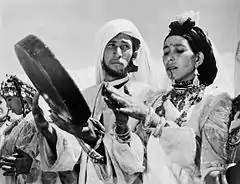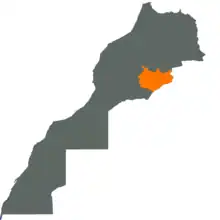Aït Atta
The Ait Atta (Berber language: Ayt Ɛeṭṭa, ⴰⵢⵜ ⵄⵟⵟⴰ) are a large Berber tribal confederation of South eastern Morocco, estimated to number about 330,000 as of 1960.[1] They are divided into "five fifths" (khams khmas), all said to descend from the forty sons of their common ancestor Dadda Atta: these "fifths" are the Ayt Wallal, Ayt Wahlim, Ayt Isful, Ayt Yazza and Ayt Unbgi. They speak Tachelhit and Central Atlas Tamazight. ("Aït" has the meaning of "people of" in the Tamazight language).[2]

The Ait Atta originated as a political entity in the Jbel Saghro region in the 16th century with the founding of their traditional capital Iɣerm Amazdar. They subsequently expanded first northwards, becoming rivals of the Ait Yafelman, then southwards, taking control of oases in Tafilalt and the Draa River. By the 19th century their raids went as far as Touat (in modern-day Algeria). They fiercely resisted the French entry into Morocco until 1933 and were the last of Morocco to fall.
At each tribal level, the head was traditionally elected according to the principles of rotation and complementarity: each lineage took turns to occupy the position, but when it was a particular lineage's turn to hold the office, only members of other lineages could choose the candidate. In ordinary circumstances, power traditionally rested mainly with local councils of family heads, the ajmuɛ, who decided cases according to customary law, izerf.[3] In the oases they conquered, the Ait Atta originally dominated a stratified society, where the haratin who worked the land were often forbidden from owning it, and needed a protection agreement with an Ait Atta patron; this stratification has considerably receded since Moroccan independence with the establishment of legal equality.
Subdivision
Source:[4]
Ait Unbi
- Ait Ihya
- Ait Amr
- Ait Irjadln
- Ait Aksil
Ait Yaza
- Ait Krad Ikhsan
- Ait Gumas
- Ait Asa
- Ait Butrurt
- Ait Hamu
- Ait Uma
Ait Ulal
- Ait Uzine
- Ait Arbse
- Ait Ulal
- Ait Buskir
- Ait Mskur
- Ait slilal
- Ait Umerjdin
- Ait Arba
Ait Wahlim
- Ait Butklifa
- Ait Huran
- Ait Masin
- Imadren
- Ait Su n Afela
Ait Isful
- Ait Anzar
- Ait Buaghrum
- Ait Hitlar
- Ait Ichu
- Ait Bafghf
- Ait Hani
Territory of Ait Atta

Significant cities and towns
Folklore
Tarrirt
According to Ait Atta stories, Tarrirt, which could be identified with Teryel is a witch which roams the mountains. She's considered to be very real and the locals are very convinced about her existence. She's supposed seen appearing on mountain peaks staring at people, or seducting and attacking men while helping and blessing women and men that treat women well.
References
- David Hart, The Ait Atta of Southern Morocco, p. 14
- Ilahiane, Hsain (2006) Historical Dictionary of the Berbers (Imazighen). Lanham, Md.: Scarecrow Press. page 12. ISBN 9780810854529
- see Boum, Aomar (2013) Memories of Absence: How Muslims Remember Jews in Morocco. Palo Alto: Stanford University Press. page 39. ISBN 9780804788519
- Muhamed Ikiss (August 2020). "156167417-The-Ait-Atta-of-Southern-Morocco-Daily-Life-and-Recent-History-David-Hart (1)" – via ResearchGate.